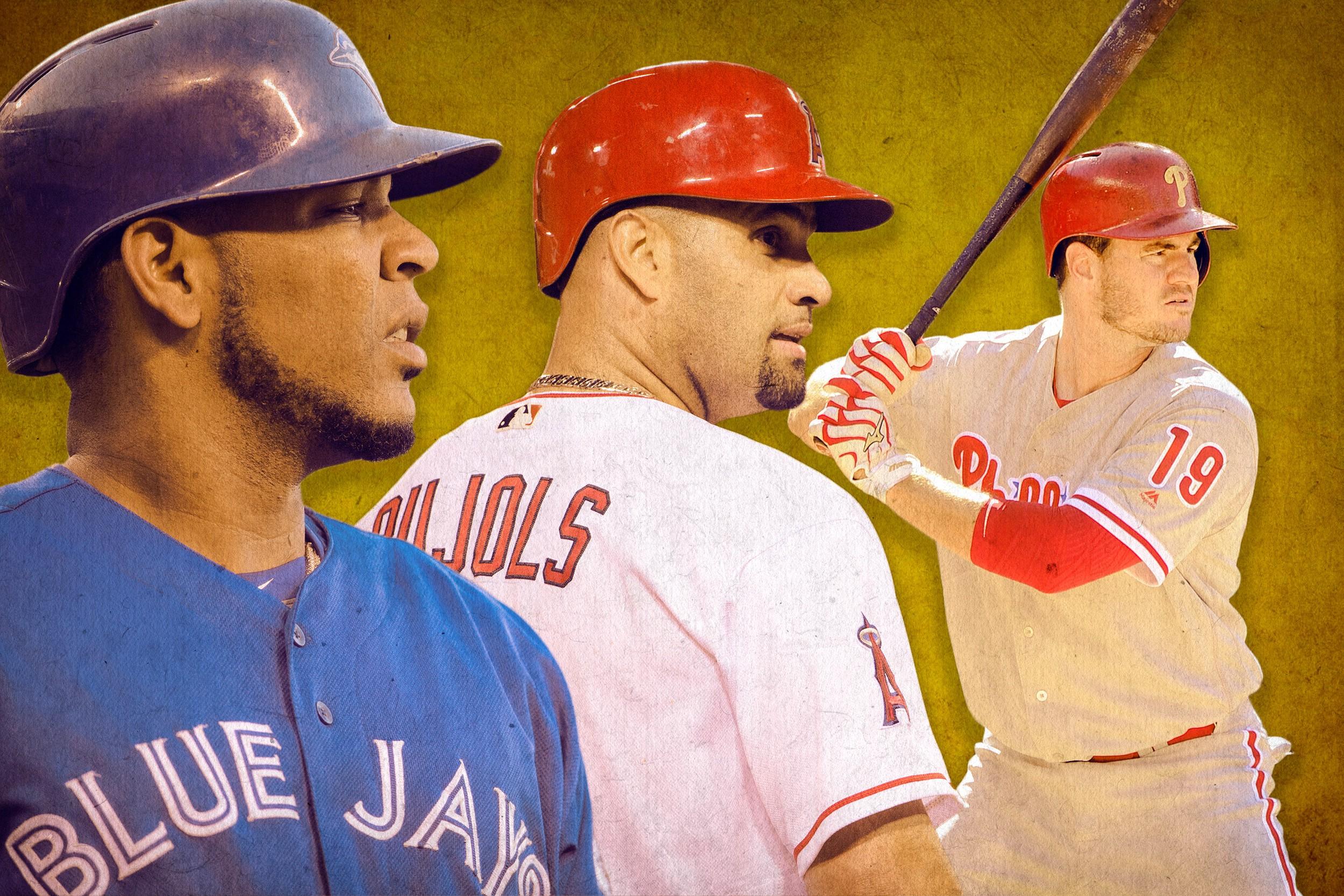
Sabermetrics may not have infiltrated fantasy baseball yet, but its lessons can still apply to online team management. Moneyball works in a fantasy context, too. In the film, Jonah Hill’s character says, “People who run ball clubs, they think in terms of buying players. Your goal shouldn’t be to buy players; your goal should be to buy wins. And in order to buy wins, you need to buy runs.” The most successful fantasy baseball managers follow this advice not by targeting specific players, but by seeking out runs (and home runs, runs batted in, stolen bases, and batting average — it’s a multi-category game).
The best way to honor that pursuit in a fantasy setting is to ignore player names and look for value. There’s no sense springing for Edwin Encarnación in the third round when Albert Pujols will be a bargain buy eight rounds later, and when a player with more rare and irreplaceable production might be available in that Encarnación spot instead. Smart drafters weigh how much production they can collect from high-priced players’ cheaper doppelgängers and plan their round-by-round strategies accordingly.
Here, for each hitting position, is the top example of a name-brand player and his bargain alternatives to seek. None of the middle- or late-round selections are better than their early-round counterparts, but they should provide reasonable value in exchange for more flexibility across the rest of the roster in the draft’s early rounds. Happy hunting! (Note: All draft position data comes from Yahoo, and all projection figures come from FanGraphs’ Depth Charts.)
Catcher: Instead of Jonathan Lucroy (going in the 8th round, on average), try Salvador Pérez (15th) or Stephen Vogt (24th)
Lucroy’s 2017 projection: 14 homers, 60 runs, 64 RBI, 3 SB, .278 average
Pérez: 19 homers, 54 runs, 65 RBI, 1 SB, .261 average
Vogt: 14 homers, 53 runs, 55 RBI, 1 SB, .259 average
Catcher is remarkably thin this year, as even the top options have question marks. Buster Posey just posted his lowest on-base and slugging percentages in five years, Kyle Schwarber and Gary Sánchez have combined for 509 career plate appearances, and Lucroy’s projected production doesn’t really outstrip that of Pérez or Vogt, each of whom is going many rounds later than the Rangers backstop.
One reasonable strategy at the position is to target a power hitter; as homers come, so do runs scored and batted in, and no catcher is projected for double digits in stolen bases, so that category is safely ignored. Since Pérez became a full-time catcher in 2013, he ranks third among MLB catchers in homers and RBI and fifth in runs; and unlike most catchers, he plays nearly every day. For a fantasy owner waiting until the end of the draft to fill the catcher slot, Vogt is a solid option, one with similar power potential and a proven track record of success in Oakland.
First base: Instead of Edwin Encarnación (3rd), try Albert Pujols (11th) or Tommy Joseph (26th)
Encarnación: 34 homers, 85 runs, 105 RBI, 2 SB, .259 average
Pujols: 29 homers, 75 runs, 103 RBI, 3 SB, .265 average
Joseph: 31 homers, 77 runs, 90 RBI, 2 SB, .261 average
Look at those projected stat lines. They’re almost identical! Encarnación is fun and hasn’t had a bad season since 2009, but there’s no reason for such a draft-position disparity between him and other first-base sluggers. Even as Pujols’s body has rusted and his game has broken down, over the past three seasons, only nine players have tallied more home runs, and only four players have driven in more runs (hitting behind Mike Trout certainly helps). He’s stayed on the field, too: Only 10 players have played more games over that span.
Joseph’s HR-per-plate-appearance ratio was a match for Encarnación’s last year, and with Ryan Howard finally gone from Philadelphia, Joseph has the starting job all to himself in 2017. As FanGraphs’ Brad Johnson noted, “Joseph had the hard hit, fly ball, and pulltastic tendencies to continue hammering,” and “the batted ball profile is reminiscent of Albert Pujols.” Fantasy managers should look for a type at first base — and that type should be 40-homer potential available in the 26th round.
Second base: Instead of Trea Turner (2nd round), try Jonathan Villar (5th) or José Peraza (16th)
Turner: 14 homers, 80 runs, 65 RBI, 36 SB, .292 average
Villar: 14 homers, 72 runs, 51 RBI, 43 SB, .256 average
Peraza: 7 homers, 63 runs, 53 RBI, 31 SB, .281 average
All three of these players can anchor a fantasy lineup in the stolen base category while adding positional versatility as an ancillary benefit. Turner is better, plays with better teammates, and is being picked like it — he’s going atop the second round in the average draft alongside established stars such as Miguel Cabrera. But Villar and Peraza are falling further than they should.
In his first 300-plate appearance season, Villar broke out last year with 19 home runs, 92 runs, and 62 stolen bases, so even with some regression, his numbers would help any fantasy owner. My affection for Peraza has been documented on this site before, but it’s worth noting again that it’s hard to find a more daring runner in the majors outside his speedy teammate in Cincinnati. Consider: Turner, who never seemed to stop running last year, attempted a stolen base on 30 percent of his SB opportunities; Villar, who led the majors in successful thefts, sat at 32 percent. Peraza beat them both, running on 36 percent of his chances. Among the 345 players with at least 70 SB opportunities last year, only Billy Hamilton had a higher such rate (45 percent).
Third base: Instead of Kris Bryant (1st), try Todd Frazier (7th) or Maikel Franco (15th)
Bryant: 31 homers, 95 runs, 97 RBI, 10 SB, .275 average
Frazier: 30 homers, 81 runs, 88 RBI, 13 SB, .241 average
Franco: 26 homers, 77 runs, 91 RBI, 2 SB, .271 average
Third base is a tricky position this year, with four studs (Bryant, Nolan Arenado, Manny Machado, and Josh Donaldson) at the top of the draft and no real second tier behind them. Justin Turner and Anthony Rendon provide good middle-round value, but not the power numbers their first-round brethren will give a fantasy owner. There are other ways to get that pop at this corner position, though: Compared with Bryant, Frazier sacrifices 30 points of batting average and Franco loses a handful of steals, but the power potential appears in similar doses for all three sluggers.
Over the past two seasons, only five players at any position hit more homers than Frazier (75), who also more than doubled the stolen base total of each of the hitters above him. Franco, meanwhile, faded down the stretch in his first full season in the majors, but he also increased his hard-hit and line-drive rates from his successful 2015 campaign. Give him a little more batted-ball luck and an improved Phillies lineup, and Franco could boost his numbers even without taking a leap skills-wise.
Shortstop: Instead of Francisco Lindor (3rd), try Jean Segura (8th) or Elvis Andrus (18th)
Lindor: 15 homers, 79 runs, 74 RBI, 17 SB, .294 average
Segura: 12 homers, 73 runs, 56 RBI, 26 SB, .271 average
Andrus: 7 homers, 70 runs, 61 RBI, 25 SB, .276 average
Exchange some power for speed, and these three like-sized shortstops could pose as offensive clones for one another. Entering his third season, Lindor certainly boasts the highest ceiling of the group, but Segura just led the National League in hits while Andrus posted career highs in nearly every offensive statistic as he powered up in his age-27 season.
Like third base, shortstop has a defined top tier without much of a middle class this year. As such, a multicategory contributor like Segura could prove to be a steal in the middle rounds; he was one of nine 20/20 hitters last season, and five (Mike Trout, Mookie Betts, José Altuve, Paul Goldschmidt, and Bryce Harper) are going in the first round by average draft position. Hitting in Texas, Andrus should contribute in every category except homers, as he was one of nine players to reach both a .300 average and 20 steals last year, along with the same elite suspects (Trout, Betts, and Altuve) and Peraza (if you needed even more convincing about his fantasy potential this year).
Outfield: Instead of Nelson Cruz (3rd), try Mark Trumbo (9th) or Brandon Moss (26th)
Cruz: 37 homers, 83 runs, 100 RBI, 3 SB, .266 average
Trumbo: 34 homers, 78 runs, 98 RBI, 2 SB, .255 average
Moss: 28 homers, 71 runs, 79 RBI, 2 SB, .231 average
One of the main takeaways from this exercise is that if you look in the right undervalued places, you can find cheap power this year, thanks to the league-wide eruption in home run rate. Consider the outfield, where Nelson Cruz provides lots of pop but not much else — Mark Trumbo, the reigning MLB home run leader, and Brandon Moss do the same at much lower costs.
Retained by Baltimore as a free agent, Trumbo will keep launching Trumbombs in Camden Yards, and Moss — a new Royal whose line admittedly contains a blot in batting average — is worth a pick at the end of a standard draft. With at least 19 homers every year since 2012, he is a sure thing in that category, and if not quite as valuable as Cruz, he’s comparable to other higher-priced sluggers such as Khris Davis (8th-round average), Adam Duvall (14th), and Joc Pederson (18th).

